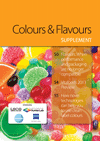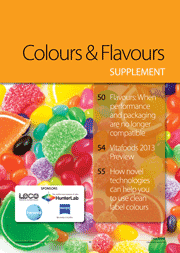Colours & Flavours supplement 2013
- Like
- Digg
- Del
- Tumblr
- VKontakte
- Buffer
- Love This
- Odnoklassniki
- Meneame
- Blogger
- Amazon
- Yahoo Mail
- Gmail
- AOL
- Newsvine
- HackerNews
- Evernote
- MySpace
- Mail.ru
- Viadeo
- Line
- Comments
- Yummly
- SMS
- Viber
- Telegram
- Subscribe
- Skype
- Facebook Messenger
- Kakao
- LiveJournal
- Yammer
- Edgar
- Fintel
- Mix
- Instapaper
- Copy Link
Posted: 26 April 2013 | Martina Lapierre, Vitafoods Europe, Colette Jermann | No comments yet
Flavours: When performance and packaging are no longer compatible Martina Lapierre (Flavour Technologist, PepsiCo)
Vitafoods 2013 Preview
(Vitafoods Europe, the global nutraceutical event)
How novel technologies can help you to use clean label colours Colette Jermann (Department of Food Manufacturing Technologies, Campden BRI)




- Flavours: When performance and packaging are no longer compatible
Martina Lapierre Flavour Technologist, PepsiCo
“The sensory threshold for difference detection can be considered to occur when there is a 30 per cent decrease in the concentration of a flavourant”. Flavourings are concentrated aroma chemical systems used in food and beverage formulations and as such are important in the provision of aroma and taste. Their sources can vary – differing mainly in type, source, cost and complexity… - Vitafoods 2013 Preview
Vitafoods Europe, the global nutraceutical event
Nutraceutical products are big business. Despite the tough economic climate and unstable raw material costs, the nutraceutical industry has shown resilience with the Freedonia Group predicting the sector will grow at 7.2 per cent annually until at least 2015…. - How novel technologies can help you to use clean label colours
Colette Jermann, Department of Food Manufacturing Technologies, Campden BRI
The trend for clean label products has been growing since the 1980s. In 2007, the well-known University of Southampton study linked certain artificial colours (tartrazine, quinoline yellow, sunset yellow, carmoisine, ponceau 4R and allura red) and the preservative benzoate to hyperactivity and attention deficit disorders in children. Since then, interest in alternative colours has grown quickly in the UK and has started to expand to the rest of Europe, mainly to Scandinavian countries…







